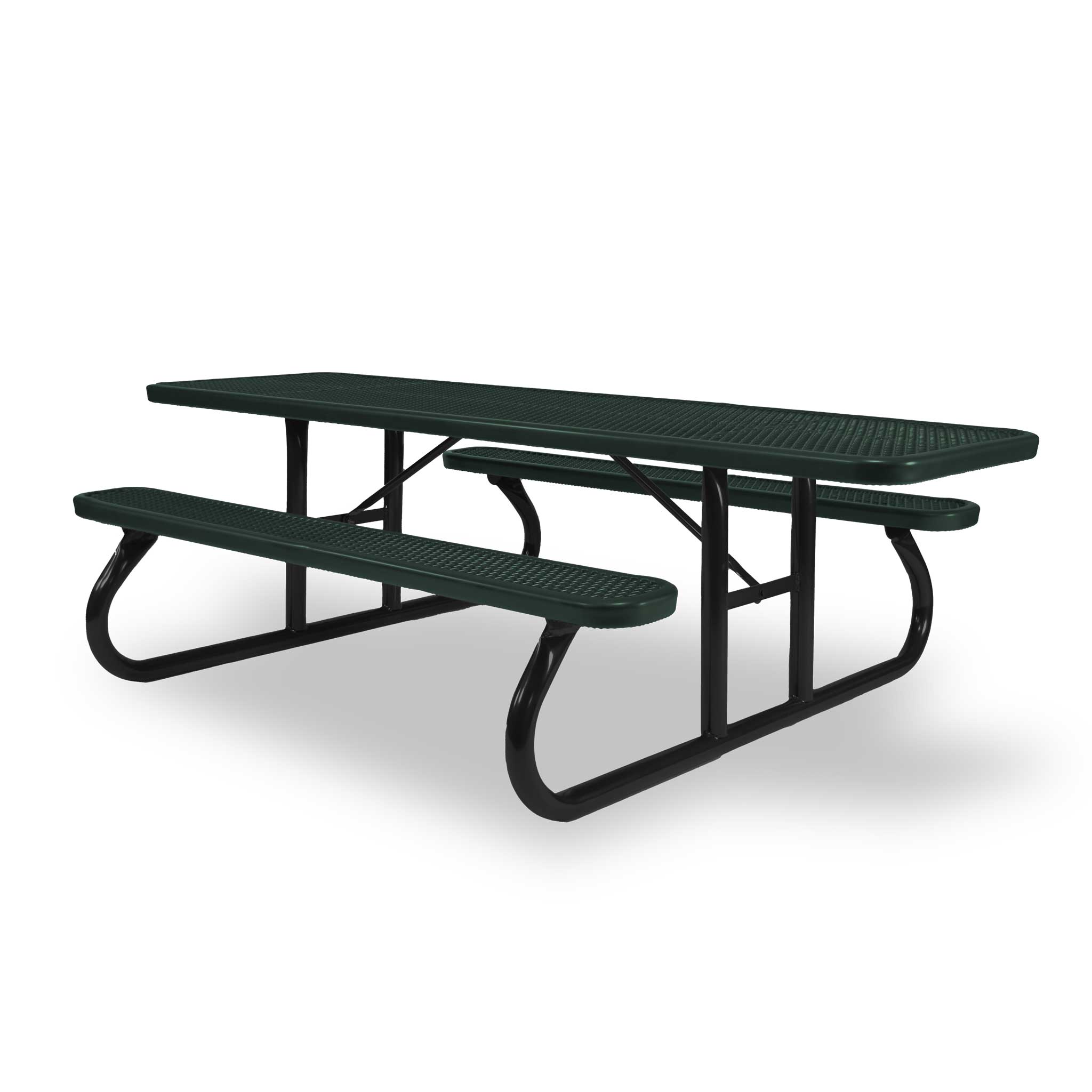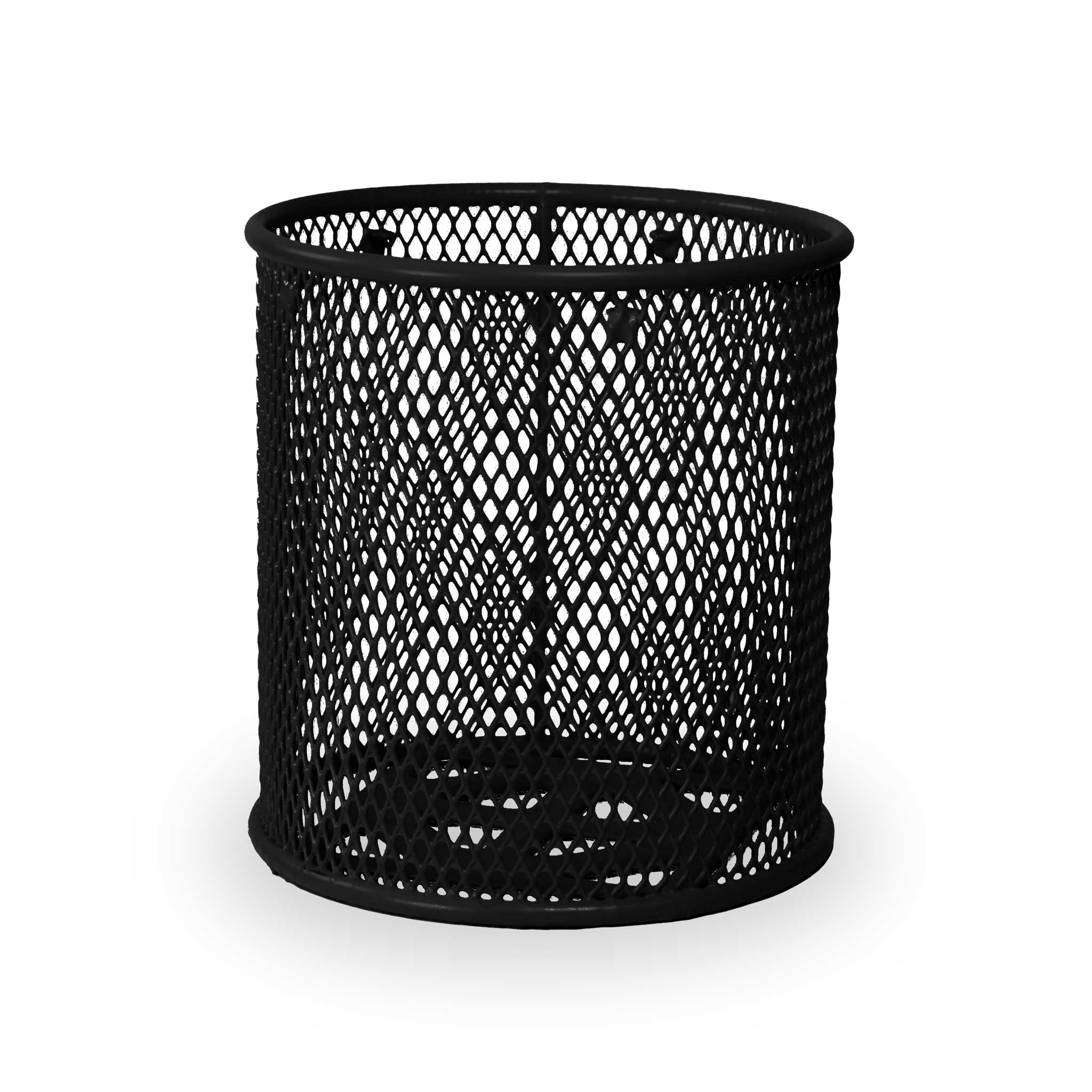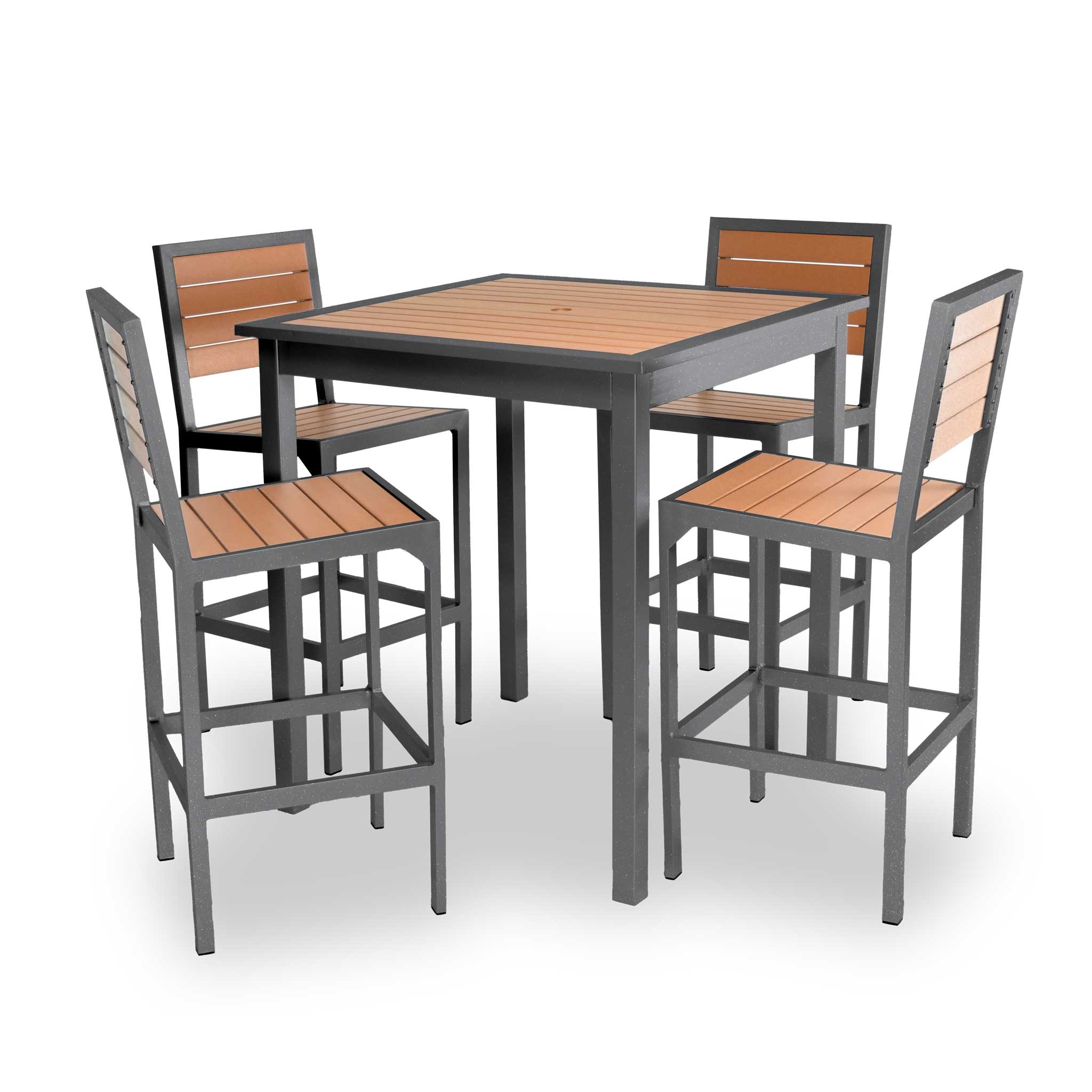Commercial Outdoor Furniture Maintenance Guide
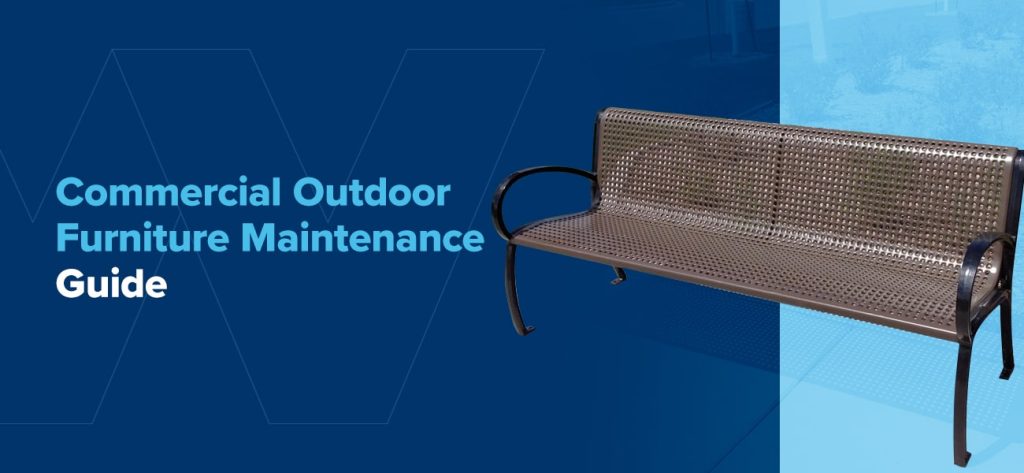
Uncategorized | Aug 23, 2022
Whether you run a restaurant, shopping mall or public park, your outdoor furnishings are just as important as your indoor products. With tables, benches, bike racks and other amenities, you show your customers and guests you care about their convenience and strive to enhance their experiences at your business. However, it can be challenging to keep your furniture in good condition with constant use and damage from the elements.
Though it’s critical to read your furniture’s manufacturer instructions and guidelines for care, there are plenty of ways you can maintain your furnishings and keep them clean. In this maintenance guide for commercial outdoor furniture, we’ll discuss how to care for different materials and products and how you can keep your outdoor space looking inviting and new.
Table of Contents
- How to Care for Different Materials
- How to Care for Different Products
- How to Protect Against Pests
- How to Create a Maintenance Checklist
- How to Create a Maintenance Schedule
- When to Replace Equipment
How to Care for Different Materials
Whether you typically go for matching materials for your outdoor furniture or like to mix and match different pieces, caring for them with preventative maintenance is an effective way to keep your furniture in top shape. Here’s how to maintain outdoor furniture of various materials:
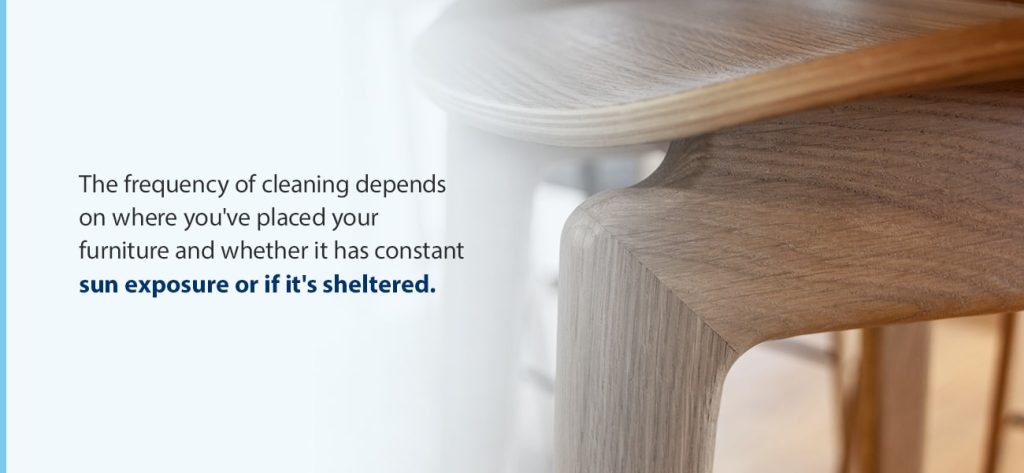
1. Wood
Wood furnishings are solid and sturdy, but they can shrink or expand due to excessive moisture and temperature changes. It’s important to keep your wood tables, chairs, benches and other furnishings clean from debris and protected from excessive moisture by performing regular maintenance.
If you’re letting your natural wood furniture age on purpose to get a faded, weathered look, known as patina, then you won’t need to clean it as often —you can get by cleaning it a few times a year. However, if you want to retain the color and texture of the wood, you’ll need to clean it more regularly and potentially add a sealant every once in a while.
The frequency of cleaning depends on where you’ve placed your furniture and whether it has constant sun exposure or if it’s sheltered. Wood furniture that constantly retains spills will also need to be cleaned immediately to prevent staining.
Here’s how to clean and maintain your outdoor wood furniture:
- Remove light debris with a soft nylon brush.
- Wipe the furniture with mild soap and water or a wood cleaner to remove buildup and grease.
- If using soap and water, soak up the excess water with a dry cloth and let the wood dry naturally.
- Check for splintering wood or broken pieces, including loose screws or missing hardware.
- Sand the wood periodically and apply a fresh coat of oil or stain to the surface to enhance the protective barrier.
For a deeper clean to remove bird droppings, mildew or rust stains, use hot water mixed with powdered oxygen bleach. Scrub the furniture thoroughly and rinse. You can also apply a clear water-repellent preservative to minimize sun damage and expansion from moisture.

2. Plastic
Commercial plastic furniture can potentially last decades outdoors thanks to its fade-resistant qualities, but excessive heat, sun exposure and sticky spills and drips can shorten its aesthetic life span. Though you don’t need to seal plastic furniture, it’s essential to clean up food and liquid residue immediately to avoid staining. Keep in mind that even sunscreen can discolor and fade some plastics.
You can use some regular commercial cleaning products meant for plastic surfaces or rubbing alcohol to remove particularly tough stains or dried, caked-on debris. If using strong chemical agents, it’s critical to rinse your furniture after cleaning to avoid fading the surface.
Here’s how to clean your plastic furniture for regular maintenance:
- Use a mild cleaner, such as mild soap, diluted vinegar or baking soda, and lightly scrub the surface with a sponge or cloth. Avoid using an abrasive material or brush, as this can scratch the surface of the plastic.
- To remove mildew, combine 10 parts water with one part chlorine bleach. Scrub, rinse and dry.
- After cleaning, check for damage to your furniture or missing hardware.
- To restore shine to your plastic outdoor furniture, you can use plastic-safe wax to help protect the surface and make it look new.
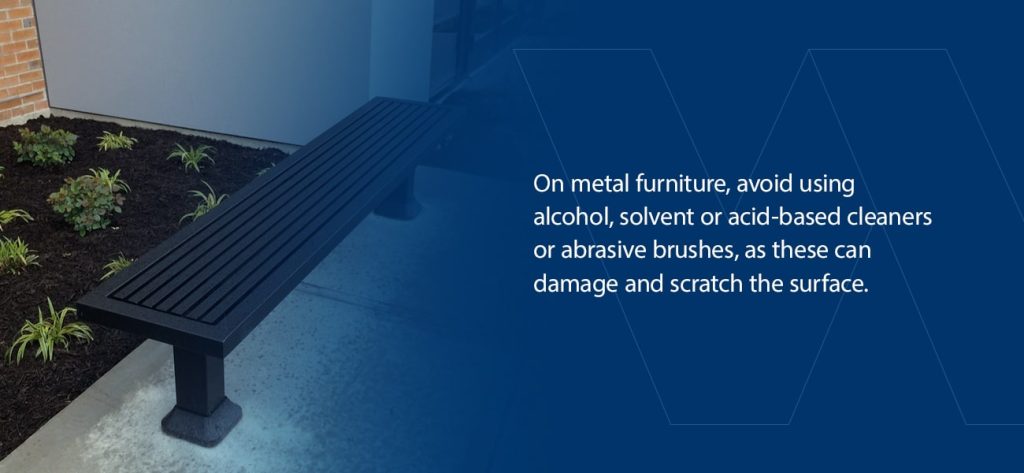
3. Metal
Metal outdoor furniture can look amazing on the patio at your business. This type of material won’t warp or crack, but if neglected, it can become corroded with rust or staining. With the right maintenance, you can avoid corrosion and keep your metal furniture in good condition.
Here’s how to clean and maintain your metal or metallic furniture:
- Remove any upholstered cushions or pillows.
- Rinse the furniture with a garden hose to remove significant pieces of debris, dirt or spillage.
- Use a non-abrasive cleaner, such as mild soap and warm water, and a soft cloth to wipe down the furniture.
- Dry with a microfiber cloth.
- Check for damage, hardware issues, chipped coating or signs of rust.
- If rust is present, gently sand off the corrosion and touch these areas up with paint.
- Apply a metal-safe coating, such as polyethylene, to prevent further corrosion and shield the metal from the elements.
On metal furniture, avoid using alcohol, solvent or acid-based cleaners or abrasive brushes, as these can damage and scratch the surface. You may also use a silicone spray to lubricate the hardware on your metal furniture if needed.
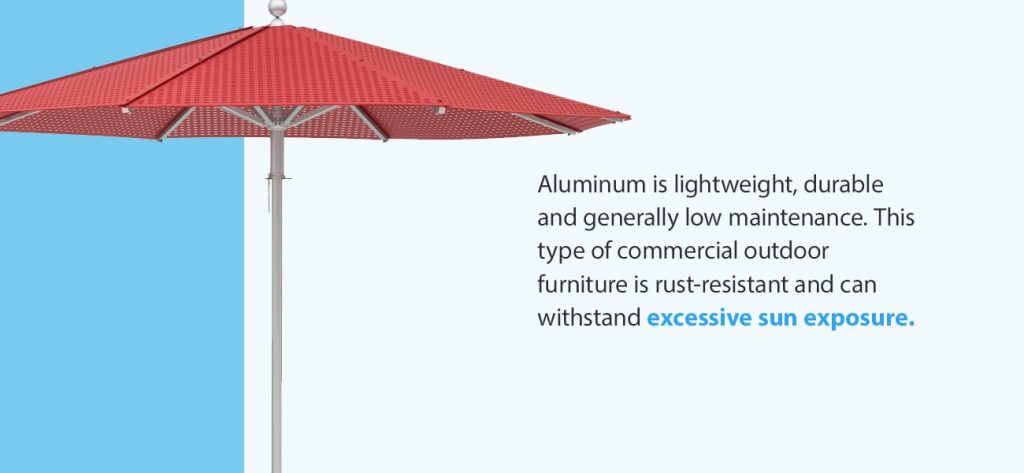
4. Aluminum
Aluminum is lightweight, durable and generally low maintenance. This type of commercial outdoor furniture is rust-resistant and can withstand excessive sun exposure. However, aluminum furniture is vulnerable to other types of corrosion, denting and scuffing.
Over time, this damage can diminish the protective integrity and strength of the material. As with other materials, the frequency of cleaning will depend on where you place your furniture and the type of climate or weather conditions your area experiences.
Here’s how to clean your aluminum outdoor furniture:
- Wash down the furniture with a gentle cleaning product and warm water. Avoid using alkaline products, which can lead to oxidation.
- Rinse and dry the furniture with a microfiber cloth.
- Inspect the furniture for damages, dents or corrosion.
- Apply a coat of car wax or baby oil to protect the material and retain the shine.
Be sure to avoid using abrasive scrubbing agents and strong chemical cleaners on aluminum furniture.
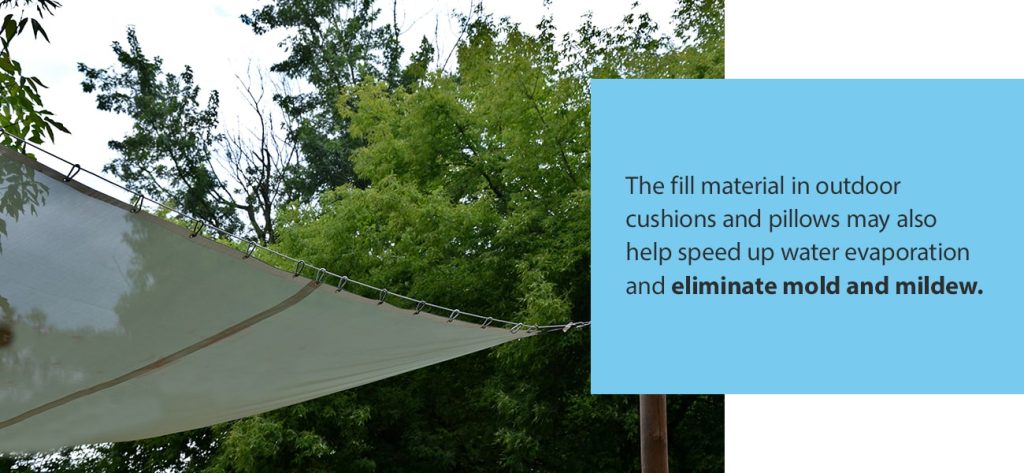
5. Fabrics
Fabric outdoor furniture can be the most comfortable option for a relaxing lounging experience. Outdoor fabrics are generally made to be water-, sun- and moisture-resistant. The fill material in outdoor cushions and pillows may also help speed up water evaporation and eliminate mold and mildew. However, as with any commercial outdoor furniture, weather conditions, climate and stain buildup can damage the look and condition of your fabric furniture.
To extend the life of the cushions, pillows and pads, clean them regularly and store them away when not in use. If you can, it’s best to keep any removable fabric pieces in a cool, dry area indoors to keep them in shape. For instance, if you expect a rainstorm to hit, you’ll want to move your fabric furniture under cover to protect it from excessive moisture damage.
Here’s how to clean and maintain your outdoor fabric furniture:
- Regularly brush off dirt and debris.
- Remove fabric cushions and pillows and rinse any non-fabric material.
- Wipe up spills, stains and sunscreen residue with mild soap and water to prevent discoloration.
- If your furniture has removable covers, machine or hand-wash them in cold water and gentle soap.
- If mold is present on fabrics, mix 1 gallon of warm water with 2 tablespoons of oxygen bleach, scrub the affected area, rinse and dry.
- To restore water-repellency, spay a fabric protector on clean, dry fabric material to enhance effectiveness. Repeat when water stops beading on the surface of the fabric.
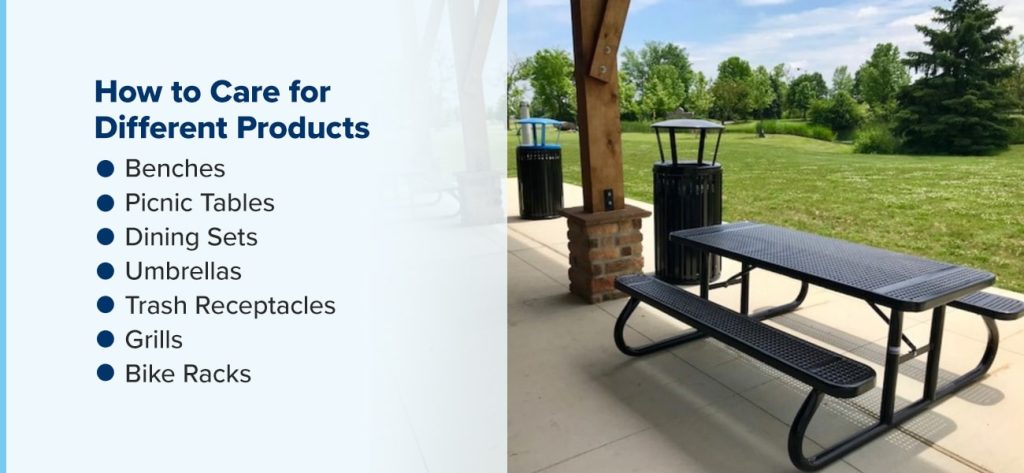
How to Care for Different Products
As with the materials above, the first step in caring for your outdoor furniture is reading all care guidelines from the manufacturer. These guidelines will often tell you what solutions you can use to clean your furniture and what agents to avoid that may cause damage.
Always be sure to read your furniture instruction manual or contact the manufacturer if you’re not sure how to properly clean stains or corrosion from these items. Below are some more general maintenance tips for common outdoor business furniture:
1. Benches
Most outdoor benches have metal, plastic or wood materials. Depending on the type of material and severity of the stain or debris, you may have to use stronger cleaning agents. Dust and dirt can accumulate over time on your benches and weaken the surface coating material.
You can typically get away with using a gentle brush or sponge and mild soap to clean and rinse your benches and keep them free of dried-on food and other stains. As with all furniture, you’ll want to regularly inspect the hardware to ensure it hasn’t begun to rust, corrode or loosen.
With wood benches, be sure to use a sealant or oil once or twice a year to keep the wood healthy and avoid splintering or stains from settling into crevices. If you can, place your benches where they may have some shade from the elements, such as under a large tree, awning or umbrella.
2. Picnic Tables
As with benches, picnic tables can be made of different materials. Depending on which type you have and how frequently customers use them, you may have to clean it more often. If you can, be sure to choose picnic tables that can hold an umbrella in the middle to protect the table and your guests from rain, heat and sun exposure.
One of the best ways to maintain the condition of your picnic tables is to move them indoors in a cool, dry place or use a table cover to protect them when not in use. If that’s not possible, you’ll still want to clean your picnic tables periodically and add a sealant or top coat that suits the material to keep them clean, protected and shiny year-round.
- Rinse off any excess dirt, debris or food and liquid residue.
- Sweep off any falling leaves, branches or pollen.
- Clean with a diluted bleach and water mixture or another gentle cleanser that your manufacturer suggests. When using any type of bleach or chemical agent, be sure to wear gloves to protect your hands.
- Using a brush or sponge, wipe down the entire surface to remove stains or kill mildew growing on the table.
Always rinse your commercial outdoor furniture after using bleach and let it dry naturally. Then, you can apply an oil or water-based sealant or touch up your table with paint to preserve its look.
3. Dining Sets
The maintenance and cleaning for outdoor dining sets are similar to picnic tables. Whether you run a restaurant or lounge or simply like to give your customers a nice outdoor place to eat or relax, you’ll want to regularly clean your dining sets to ensure they remain free of stains and look brand new for as long as possible.
If you can, position your outdoor dining tables, chair or sets under a shaded area, pavilion, large tree or umbrella to avoid excessive sun and heat damage. If your dining sets are used daily, you should wipe them down every evening with soap and water to avoid food and liquid buildup and prevent attracting pests looking for crumbs.
Sweep or rinse away any excess dirt or sticky residue and gently create a soapy lather on the table, including the seats and legs. When finished, rinse off the table completely and dry excess water.
4. Umbrellas
Outdoor umbrellas are relatively easy to care for, but when using them to protect your other furniture from the elements, they can often receive the most damage. Whether you’re experiencing a hot, sunny, rainy or windy climate, it’s key to regularly rinse off your umbrellas from debris, bird droppings, dust and pollen.
When not in use, fold your umbrellas and store them in a cool, dry place. Check the hardware and pole on your umbrellas to ensure there’s no rust or corrosion that could prevent them from closing. Read the manufacturer’s label to determine if there are any specific care instructions.
5. Trash Receptacles
If you don’t clean or care for your trash receptacles, it can lead to excessive odor and cause insects, rodents and birds to flock to your trash and deter customers and guests. It’s essential to make sure your trash receptacles are emptied regularly to avoid overflowing and allow guests to dispose of their trash without littering.
To keep them clean, empty the trash completely and use a brush to give them a thorough cleaning. Be sure to wear gloves and hose the trash cans down with soap and water to get off debris, dirt or any sticky food or liquid that leaked onto the outside. To keep odor and bacteria at bay, spray a disinfectant cleaner or use baking soda to scrub off tough stains and leave your trash receptacles smelling clean.
6. Grills
Outdoor grills will need to be cleaned after every use. To maintain your grill and keep it clean, you’ll want to remove and clean the grates with a stiff wire brush. On the inside of the grill, you can use mild soap and water if it’s particularly dirty or greasy. Dry the grill thoroughly with a rag and make sure it’s dry before using it again.
If there are excessive bits of burnt food leftover on the grill, you can heat it up to burn these parts off and make them easier to scrape clean. If your grill has a lid, always keep it closed when not in use. Cover your grill with a tarp if you know it won’t be used or if there’s a severe weather warning. Refer to the instruction manual for specific care instructions on your grill.
7. Bike Racks
Bike racks may easily accumulate dirt, grass, dust, gravel and other debris from bike tires rubbing against them. Over time, this can create a dull appearance. To help maintain the look and integrity of your bike racks, clean them often to remove dirt and road particles that can lead to corrosion.
Using a garden hose, soak the bike rack in warm water to remove any loose deposits. With a soft nylon brush and dish soap or carwash detergent, scrub the entire bike rack and in between each grate. Then, rinse it clean and wipe it down with a dry microfiber cloth. To restore luster, you can use a non-abrasive acrylic protectant with a rag to buff the product onto the bike rack and protect the surface from pollutants and salt water.

How to Protect Against Pests
In addition to the elements, pests can wreak havoc on your outdoor patio furniture and make it uninviting for guests and customers. Protecting against pests can improve the longevity and aesthetic appeal of your outdoor furnishings.
Always keep your furniture free from food remnants, spilled drink residue and garbage to avoid attracting various pests. Here are some solutions to combat different types of pests:
- Insects and rodents: Deter bugs and rodents with regular cleaning. Spray essential oil around your furniture to repel them and make your space smell more appealing. Be sure to check any nooks and crevices in your furniture where bugs may want to hide or build a nest. You can also burn citronella lamps or candles to keep mosquitos and flies away.
- Birds: It can be difficult to keep birds from landing on your outdoor furniture and leaving droppings, but adding predator decoys, such as fake eagles or owls, can keep them away. You can also add metallic wind chimes or reflective pinwheels to deter birds, as they dislike shiny, moving things.
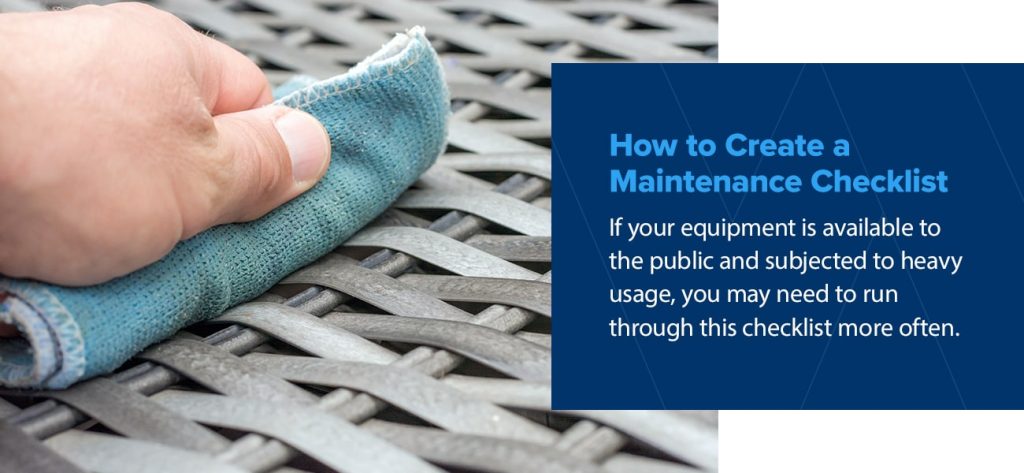
How to Create a Maintenance Checklist
Your cleaning and maintenance checklist will look different depending on a few factors. If your equipment is available to the public and subjected to heavy usage, you may need to run through this checklist more often. However, if your outdoor furniture is only used by customers a few days a week, you might be able to do this maintenance less frequently.
Use the following checklist as inspiration to ensure you’re covering the critical steps and properly maintaining your outdoor site furnishings:
- Inspect for loose or missing hardware. Tighten and replace as necessary.
- Remove grime, dirt and grease.
- Clean materials often with soap, water and a brush.
- Lubricate parts periodically if needed.
- Repair cracks or chips if possible.
- Remove damaged furniture.
- Fix cracked or broken joints and welds.
- Touch up surfaces with coating or paint.
- Examine wood furnishings for splintering and sand if necessary.
- Fix loose seats, legs and other parts.
- Create a maintenance and inspection schedule that works for your business.
- Monitor for vandalism or misuse that can lead to damage.
Document who performs these steps so you know when the maintenance occurs each time.
How to Create a Maintenance Schedule
Though your maintenance schedule will depend on your location, common weather conditions and how often your furniture is used, it’s important to at least clean your furniture a few times a year. With a daily maintenance schedule, you’ll want to clean up spills and messes as soon as they happen, rinse or sweep off crumbs to avoid pests and check for dents or damage. You can also go by your manufacturer’s recommendations for cleaning frequency.
With a seasonal maintenance schedule, you’ll want to ensure weather conditions are not ruining the surface of your furniture. In spring and summer, provide shade and protection from sun rays on your plastic or wood furniture by covering your furniture with umbrellas or keeping it under shaded structures to prevent moisture damage. In the fall and winter, cover your outdoor furniture or move it inside if you live somewhere where it snows or hails during these seasons.
When to Replace Outdoor Furniture Equipment
High-quality outdoor furniture is designed with the elements of nature in mind so it can last for years. With proper maintenance and cleaning, your site furnishings can last even longer. However, there are a few ways to tell when it might be time to get rid of your outdoor furniture and replace it with a new set.
- Creaking: One of the first signs of determination when sitting on outdoor furniture is creaking or wobbling. These creaking noises can let you know your furniture is about to tear or break, so it’s likely time for a replacement.
- Rust or mold: While you can typically clean minor rust and mold, excessive amounts can make your furniture unusable and uncomfortable to sit on. Rust and mold can cause your furnishings to break down and be unsafe for guests and customers.
- Expansion or warping: Low-quality plastic and wood furniture can begin to fade, contract, expand or warp after consistent exposure to moisture, heat and sunlight.
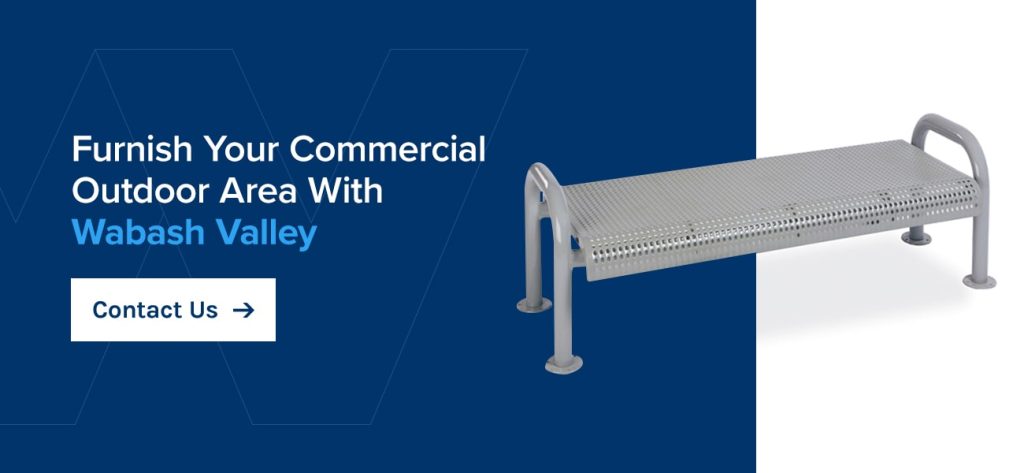
Furnish Your Commercial Outdoor Area With Wabash Valley
Whether you want to replace a few of your outdoor furnishings or create an entirely new area for guests and customers to enjoy, Wabash Valley Site Furnishings has everything you need to design an outdoor space that meets your needs. We offer a wide selection of tables, benches, chairs, litter receptacles, planters and many more furnishings that are aesthetically pleasing, high-quality and durable, so you can enjoy them for years to come.
At Wabash Valley Site Furnishings, we know that outdoor amenities can truly make a difference to your overall design. With various styles and colors, we know you’ll find the right pieces to fit in with your community park or business. Browse our products today to get started!
Categories
Recent Posts
Sign up for our newsletter
Share this post:

